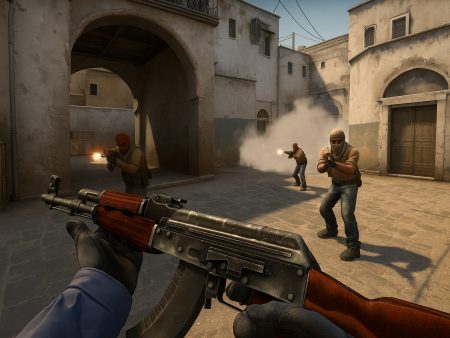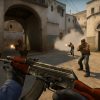Master every smoke, flash, and molotov on Ancient in CS2 with this complete utility guide. Learn pro lineups, execute strategies, and dominate with map control tactics. Perfect for both T and CT sides.
Ancient isn’t just another map in CS2—it’s a tactical battleground that demands a deep understanding of utility and positioning. What sets Ancient apart from maps like Mirage or Inferno is its layout: tight corridors, long sightlines, and bottlenecked entry points make utility usage not just beneficial but absolutely essential.
Unlike traditional maps where teams can brute-force their way with sharp aim, Ancient punishes players who ignore grenade setups. The map’s layout—especially the B-lane and mid—creates constant choke points where one well-placed smoke or flashbang can decide the outcome of a round. Its green, overgrown aesthetic also makes visibility slightly trickier, especially when contrasting dark player models blend with the foliage. This makes learning specific grenade lineups even more critical.
One of the biggest tactical challenges is the long rotations, especially from A-site to B-site or vice versa. Without proper mid control and efficient utility, defending or retaking a site becomes ten times harder. And for T-side, gaining space without utility is borderline suicide.
In short, Ancient isn’t for run-and-gunners who play off raw instinct. It’s built for the cerebral player—the one who knows when and where to throw a flash, molly, or smoke to tip the odds.
Why Utility Mastery Matters on Ancient
If you’re not mastering utility on Ancient, you’re not playing the map right—plain and simple. Good utility use isn’t just about execution—it’s about manipulating enemy vision, movement, and positioning. This is especially crucial on a map like Ancient where vision and space are already limited.
Let’s say you’re attacking A-site. Without a donut smoke and a CT-blocking smoke, you’re walking into a crossfire where defenders can hold from 3-4 angles simultaneously. But with a couple of smokes and a well-timed flash, you isolate duels and make life hell for the defenders.
On defense, it’s the same story. Want to delay the T-push down B-lane? A smoke and molly combo buys you an extra 10 seconds. That’s enough time for a teammate to rotate or catch someone off-guard.
Mastering utility gives you map control, slows down rushes, helps in site retakes, and forces your opponents to burn through their own grenades inefficiently. It’s the invisible sixth player on your team—if you know how to use it, you’ll dominate.
Key Callouts and Map Overview
A-Site Key Locations
Understanding Ancient’s A-site is key to mastering your smokes and flashes. A-site is more exposed and open compared to B, but with fewer direct entry points, making it easier to hold with proper utility.
Key Callouts:
- A-Main: The main terrorist entrance to the A-site.
- Donut: A crucial connector that links mid to A.
- Temple: CT-side post-plant hold area.
- CT Spawn: Common rotation path and entry for CTs.
- Default Plant: Right at the front of Temple.
T-side needs to smoke off CT and Donut to ensure a clean site entry. CTs often play from Temple, hugging cover and using the donut as a secondary chokehold. A-site is all about quick entries, tight flashes, and denying vision.
B-Site Key Locations
B-site on Ancient is a bit of a fortress. It has multiple corners, cubbies, and a long lane that makes it difficult to push without solid coordination.
Key Callouts:
- B-Main: Terrorist entryway to the site.
- Cave: Close-quarters hold area, often smoked or mollied.
- B-Lane: Long, narrow approach path from T-side.
- Back Site: Safe CT hold zone.
- Ramp: Elevated CT rotation point.
This site demands molly usage to clear corners, smokes to block vision from back site and cave, and pop flashes to force defenders out of hiding. CTs can lock down the site with a single well-timed smoke or flash, while T-side needs utility to even the odds.
Mid Control Zones
Mid control on Ancient is more than just optional—it’s mission-critical. Whoever owns mid has easier access to flanks, rotates, and both sites. But it’s also the most contested area of the map.
Key Callouts:
- Mid Doors: Standard point of entry.
- Donut: Again, crucial connector.
- Jaguar: CT-side position used for mid control.
- Cave Entrance: Leads to B.
Winning mid requires quick smokes for donut and doors, followed by a solid flash to push off defenders in jaguar. From here, Ts can split B or pressure A from donut. Mid is all about timing and who lands their utility better.
Essential Smoke Lineups on Ancient
A-Site CT Smoke
This is one of the most crucial smokes for any A-site execute on Ancient. Without it, CTs can easily hold long-range angles from Temple and CT spawn, which puts your entire push at risk.
How to Throw It:
- Stand outside A-main near the right wall.
- Aim at the top leaf in the tree in the skybox.
- Jump-throw the smoke.
Why It Works:
This smoke blocks vision from CTs holding temple and prevents rotates from peeking directly. It gives your team a better chance of planting and forces the defenders to push through smoke or rotate around.
Pro Tip: Pair this smoke with a Donut smoke to isolate the site entirely. And don’t forget to flash through before pushing. The more CTs blinded, the easier your entry becomes.
Donut Smoke
Donut is one of the hardest angles to deal with, especially when a CT player holds it with an AWP. Smoking it off during an A execute is a must.
How to Throw It:
- Head toward mid.
- Position yourself near the boxes and align your crosshair with the building edge.
- Use a jump-throw bind to get it to land perfectly.
Why It’s Important:
This smoke cuts off one of the biggest angles of pressure from the mid connector and forces donut players to reposition. It also makes site holds awkward for CTs, especially if they’re relying on crossfires.
Pro Tip: You can molly donut just before throwing the smoke to force an aggressive player out into the open.
Flashbang Lineups That Win Rounds
A‑Main Entry Flash
When executing A‑site, a well‑timed flash through A‑Main can blind defenders holding Temple or CT spawn, allowing your riflers and AWPer to entry safely. Here’s a reliable lineup:
How to Throw It:
- Start just inside A‑Main, hugging the right wall near the corners.
- Aim at the top corner of the stone arch (just under the skyline).
- Jump-throw the flash.
Why It Works:
The trajectory arcs perfectly into the site, popping in front of the Temple area and behind short cover. Defenders expecting an entry are often caught off guard, especially when it bursts late and blinds deep angles. Use this flash in sync with your smoke throws so CTs can’t adjust.
Pro Tip: Wait until your smoke is nearly in place, then send the flash ~0.2–0.3 seconds after to maximize surprise.
B‑Lane Pop Flash
The B‑ Lane approach is long and linear, which gives you an opportunity for a popup flash to blind defenders in Cave or Back Site.
How to Throw It:
- Start from B‑Main corner (just before entering the lane).
- Aim at the top of the far vertical wall or near a window ledge.
- Use a normal throw (no jump needed) so the flash curves over the top and pops near the site entrance.
Why It Works:
This flash arcs over the entrance and bursts right as it clears any boxes, forcing defenders back or blind. It also helps you clear the initial corners before your team pushes.
Pro Tip: Watch your teammates’ positioning — if someone is walking through B‑Main, coordinate so they don’t get flashed by your own utility.
Mid‑Peek Flash for Teammates
Controlling mid is essential on Ancient. A flash that blinds Jaguar or Donut helps your teammates push through or cross safely.
How to Throw It:
- Position just outside mid doors or at the door corner.
- Aim about mid‑level on the wall opposite mid.
- Jump-throw or normal throw depending on your distance.
Why It Works:
The flash arcs into Jaguar / Donut area just as someone is pushing, blocking common defensive spots and giving your teammate the jump. Since defenders often play those angles tightly, even a small flash can open mid control.
Pro Tip: Use this flash in tandem with a smoke to block the main sightline, so the defender can’t turn away before the flash pops.
Molotov Lineups for Maximum Impact
Donut Control Molotov
Donut is a hotspot for defenders to lurk in and contest your advance. Mollying it before or right after the smoke helps flush them out.
How to Throw It:
- Stand near mid‑to‑donut connector.
- Aim just above the ledge or a distinguishing roof corner.
- Use a standard molly throw (no jump) so it curves and lands inside the donut area.
Why It Works:
The molly lands near the base of the donut, burning defenders out of their position and forcing them to expose themselves if they want to contest. It also punishes any lingering post-plant hold there.
Pro Tip: If you timed the smoke slightly late, throw this molly just before or immediately after to maximize utility usage.
A‑Default Molotov
When defenders hold tight within A‑site (especially around Temple or Default Plant), a molotov can push them out or force reposition.
How to Throw It:
- From A‑Main mid‑area or just inside the site, aim toward Temple roof edge or Default Plant wall.
- Use a jump-throw (or standard depending on distance) to throw it high and land deep.
Why It Works:
It forces defenders either to reposition deeper (losing crossfire angles) or take damage to stay put. Especially useful when the smoke has masked your advance and you want to deny common angles.
Pro Tip: If you combine this with a flash, defenders have minimal time to react before being forced out or taking damage.
Cave to Back Site B Molotov
On B‑site, defenders often hide deep in Back Site or crouch in corners within cave. A molotov from cave area helps control those positions post-execute.
How to Throw It:
- From B‑Main or just inside cave, aim at the top roof corner or wall edge opposite back site.
- Use a jump-throw or a perfectly angled high throw so it arcs into the back site corners.
Why It Works:
It lands deep in back site, burning defenders out into more exposed positions or making them rotate early. Especially effective when paired with your B-site smokes and flashes.
Pro Tip: If you toss it early, defenders might hear or see it — better to throw after your initial smokes but before your final push.
Pro Tips to Master Ancient Utility
Timing Your Grenades
Grenade timing can make or break rounds. Even the perfect lineup fails if thrown too early or too late. Here are essential timing tips:
- Sequence matters: smoke → flash → molly → entry is typically ideal. But don’t rigidly stick to it; adapt to the round progression.
- Delay slightly: throw smoke ~0.5 seconds before flash to block vision, then flash into the gap.
- Staggered throws: don’t throw all utilities at once. Let smokes bloom, flash pop, and move together.
- Watch rotations: if CT rotates late, a secondary smoke or molly mid-round can disrupt them.
- Save utility for retakes: even if your execute is messy, hold a smoke or flash for retake scenarios.
Mastering the above will help your team’s mid-round flexibility—vital on a map like Ancient.
Communicating Lineups in Team Play
Even the best lineup is useless if your team doesn’t know it’s coming. Communication is key:
- Call grenade types & timing: “Smoking CT now,” “Flashing A‑main in 1,” etc.
- Use short names: refer to “Donut,” “Temple,” “Jaguar,” etc. so everyone knows the intended target.
- Stack calls: If multiple grenades target the same zone, call them — e.g. “Molly Donut, smoke CT, flash A‑main.”
- Watch crossfire liability: ensure your utility doesn’t blind or hurt your teammates. Always verbalize “flash over me,” “molly out,” etc.
- Review after rounds: talk through failed rounds and what went wrong in utility timing or placement.
Good communication ensures your lineups aren’t wasted or counterproductive.
Best CT‑Side Smokes and Nades
Mid Denial Smoke
Preventing terrorists from gaining mid control is crucial. A well-placed mid smoke disrupts their push.
How to Throw It:
- Stand near CT Side or Jaguar area.
- Aim at the top of the mid‑door frame or just above the ledge across.
- Jump-throw or standard throw based on your position.
Why It Works:
This smoke blocks visibility from Donut into mid, making it harder for Ts to split B or threaten A from mid. It forces them to either push blind or use extra utility to clear.
Pro Tip: Use it early (within first 10–12 seconds) if you suspect aggressive mid pressure.
A‑Main Push Counter Nade
When Ts push through A‑Main aggressively, a counter‑nade (flash or molly) can cripple their advance.
- Flash: Send a short flash just over the arch into A‑Main, before they can peek.
- Molly: Fire a molotov into the A‑Main corridor to burn players trying to entry quickly.
Why It Works:
It forces hesitation or slows their push momentum, giving you more space to retreat or reposition defensively.
Pro Tip: Use these when you anticipate a fast execute, often around the 20–25 second mark on T-side.
B‑Ramp Retake Utility
If Ts manage to take B, CTs might need to retake. You need smokes and flashes to block key angles and aid a retake.
Smoke ideas:
- Cave entrance smoke: blocks vision from cave into B-lane.
- Mid-to-B connector smoke: denies flank vision.
Flash ideas:
- Pop flashes over ramp or from ramp toward back site.
- Flash from cave into B main when pushing from multiple sides.
Why It Works:
These utilities allow entry and limit exposure, making coordinated retakes feasible. On a map with many tight corners like Ancient, well-timed flashes are lifesavers.
Pro Tip: Wait until both sides are ready, then flash in together to reduce crossfire risk.
Best T‑Side Smokes and Nades
A-Site Execute Utility Set
Executing onto A-site on Ancient as a T-side team requires more than just running in with rifles. It demands precision smokes and perfectly timed flashes to neutralize CTs holding from Temple, Donut, and CT spawn.
Utility Combo:
- Smoke CT – as detailed earlier, this smoke blocks the Temple and CT cross.
- Smoke Donut – denies the mid connector, forcing repositioning.
- Molotov Default or Close Corner – clears lurking CTs holding tight angles.
- Flash A-Main Entry – pops deep to blind defenders near CT or on-site.
Why It Works:
This full execute creates a wall of denial. CTs either play blind or must fall back to retake. These setups also allow a safe default plant, especially when you maintain A-Main control after planting.
Pro Tip: Time the smoke bloom before the flash to ensure CTs are disoriented and can’t swing wide angles.
B-Site Default Clear Setup
B-Site is a nightmare to enter without clearing tight corners like Cave, Back Site, and Ramp. A proper nade set can make or break your round.
Utility Combo:
- Molly Cave Entrance – burns out campers.
- Smoke Back Site – blinds any AWPer or rifler playing deep.
- Flash Over B-Main – blinds lane holders.
- HE Grenade for Cubby – a common off-angle where CTs sit tight.
Why It Works:
This set removes multiple threats. By using a molly to flush Cave, you’re avoiding the classic crossfire trap. The back site smoke blocks vision and gives Ts room to plant. Meanwhile, the flash clears anyone holding aggressively near the lane.
Pro Tip: Always have a player peek immediately after the flash – utility without follow-up is wasted potential.
Mid Control Utility
Mid control allows for site splits, rotations, and fakes. The key to controlling mid is smart, early utility usage.
Key Setups:
- Smoke Donut or Doors – this denies mid CT vision.
- Flash Jaguar – blinds mid-pushes from CTs.
- Molly Boxes or Ladder – stops aggressive holds or boosts.
Why It Works:
It denies the CTs from locking down mid early. Without mid control, T-side strats become stale and predictable. Once you smoke doors and flash jaguar, push with at least two teammates—one to clear angles, another to watch the flank.
Pro Tip: After gaining mid, decide quickly—split B via Cave or fake A with donut pressure. Don’t linger or CTs will re-smoke and retake mid.
Practice Configs and Workshop Maps
Setting Up a Practice Server
To get good at utility, you must practice lineups offline. CS2 gives plenty of flexibility to set up your own server with no bots and infinite nades.
Config Essentials:
sv_cheats 1sv_infinite_ammo 1ammo_grenade_limit_total 5sv_grenade_trajectory 1sv_grenade_trajectory_time 10sv_showimpacts 1god
With these, you can throw grenades repeatedly and see their arcs. Practicing this way builds muscle memory and confidence for live matches.
Pro Tip: Combine with noclip (bind v noclip) to fly and see exactly where your nades land.
Recommended CS2 Workshop Maps
Several custom-made CS2 maps are designed specifically for practicing utility. These are goldmines for perfecting smokes, flashes, and mollies.
Top Picks:
- Yprac Ancient: Complete utility trainer for Ancient with visual markers and instructions.
- uLLeticaL’s Training Map: Offers utility training plus aim routines.
- Crashz’s Config Generator: Helps you set up a perfect practice environment.
Why They Work:
These maps are interactive and beginner-friendly. They even show bounce trajectories, jump-throw spots, and timing indicators. Use them daily to sharpen your lineup skills.
Common Mistakes Players Make with Utility
Wasting Nades Too Early
Too many players throw smokes and flashes within the first 10 seconds of a round with no clear objective. This is one of the worst habits in CS2.
Problems with Early Nade Use:
- You have no info on the enemy yet.
- CTs bait utility with fake steps.
- Leaves you dry for post-plant or late-round executes.
Fix It:
Wait. Use audio cues, gather info, and coordinate your nades around real threats. Think of grenades as chess pieces—use them when they can trade actual value.
Pro Tip: Let enemies burn their utility first. Play reactive utility instead of aggressive nades every round.
Poor Lineup Execution
Ever watched a teammate smoke CT and it lands mid-site? Happens a lot. Bad lineups = lost rounds.
Common Causes:
- No practice.
- Wrong crosshair placement.
- Rushing throws without setting up.
Fix It:
Practice religiously. Use workshop maps. Save screenshots of key lineups or record demos. Eventually, it becomes muscle memory.
Pro Tip: Use the jump-throw bind for precision every time:bind v "+jump; -attack; -jump"
Overstacking One Site with Utility
A common T-side mistake: dumping all smokes, mollies, and flashes into A-site for a failed push, then having nothing left for B or mid.
Why It’s Bad:
- CTs rotate after hearing full utility dump.
- You have no post-plant utility.
- Your next plan becomes weak and readable.
Fix It:
Split your utility between entry, control, and post-plant phases. If you’re faking A, don’t use everything—just smoke and flash one angle. Save the rest for your real hit.
Pro Tip: Always keep one smoke and flash for post-plant control—especially if you’re playing for a retake or site hold.
Watching the Pros – Learning from Top Players
Notable Pro Teams Using Ancient Effectively
Want to learn how to play Ancient like a beast? Watch top-tier teams who dominate on this map:
- Natus Vincere (Na’Vi) – masters of mid control and delayed executes.
- Heroic – brilliant use of utility to fake and confuse.
- Vitality – tight utility usage around Donut and B.
- FaZe Clan – aggressive CT utility for early map control.
These teams don’t just throw nades—they manipulate the map with them.
What You’ll Learn:
- How pros stagger nades.
- Where they hold post-plant positions.
- How they deny mid access with minimal risk.
Pro Tip: Don’t just watch frag movies—study full match demos on Ancient. Focus on utility usage, not just aim.
How to Replicate Their Utility Strategies
Want to use pro utility in your own matchmaking or scrims?
- Download their demos (HLTV, Steam, YouTube).
- Record timestamps of utility throws.
- Load demo, pause at grenade throw moment.
- Go into a custom server and replicate step-by-step.
It’s like watching a cooking tutorial—follow the steps and perfect the recipe.
Pro Tip: Combine utility with teammate positions—don’t just memorize throws; learn why they throw when they do.
Adjusting Your Utility Based on Opponent Playstyle
Aggressive vs Passive Opponents
Knowing your enemy’s tempo is half the battle—especially when it comes to utility usage. If you’re up against an aggressive team, their goal is to take early control with brute force. Meanwhile, passive teams will sit back and wait, hoping you waste your utility or make a mistake.
Against Aggressive Enemies:
- Use early counter-nades — molotovs and HE grenades to delay rushes.
- Play deeper angles — bait them into a flash or crossfire trap.
- Don’t overpeek — let your utility do the work and punish their overextensions.
Against Passive Enemies:
- Use probing utility — throw fake smokes or flashes to draw out their nades or force movement.
- Keep one molly for late round — passive players often strike at the 30-second mark.
- Watch the clock — bait utility out of them early by faking mid-control or B executes.
Pro Tip: Adapt round by round. If a team runs mid-heavy plays twice, they’re likely to slow down next round. Change up your smokes or pre-mollies to keep them guessing.
Counter-Nading and Adapting
Every round is a chess match—and counter-nading is your best gambit. Learn the opponent’s usual utility patterns, then use yours to cancel or punish them.
Examples:
- CTs always smoke A-Main? Delay your push, molly the smoke, then push once it clears.
- Ts molly Jaguar every round? Toss a pop flash and peek mid aggressively for a punish.
- CTs play triple B setup? Fake utility there and strike A with minimal resistance.
How to Adapt Mid-Match:
- Keep mental notes (or callouts) of utility patterns.
- Make small utility changes—not everything at once.
- Save a smoke or flash to react—don’t pre-commit all grenades.
Pro Tip: Ask your teammates to hold or delay their smokes until the first 15-20 seconds unless you’re rushing. This makes your team flexible and unpredictable.
Conclusion
Mastering Ancient in CS2 isn’t just about hitting headshots—it’s about owning the battlefield with your utility. This map thrives on tactical play, and your smoke, flash, and molotov lineups are your secret weapons. When you throw the right utility at the right time, you create openings, delay enemy advances, secure bomb plants, and win retakes with ease.
From A-site executes to mid-control flashes, every grenade has a purpose on Ancient. Practice those lineups until they become second nature. Use workshop maps, set up custom servers, and watch how the pros do it. More importantly, communicate with your team and adjust your utility based on what the enemy throws at you.
Utility is your sixth sense in CS2—and on a map like Ancient, it’s your best friend.
Now go smoke off CT, flash through Donut, and show your opponents why Ancient is your kingdom.
FAQs
What is the most effective smoke for A-site on Ancient?
The CT/Triangle smoke is arguably the most crucial. It blocks the view from Temple and CT spawn, allowing safe entry from A-Main and easy bomb plants. Combine it with a Donut smoke for full site control.
How do I consistently throw utility in CS2?
Use practice servers with sv_grenade_trajectory 1 and workshop maps like Yprac. Set up jump-throw binds and record common lineups. Practice until every throw is muscle memory.
Are there changes in utility physics from CS:GO to CS2?
Yes, CS2 features updated physics, including improved grenade bounces, faster molotov spread, and more accurate throw consistency. Some CS:GO lineups may not work identically in CS2—always double-check.
What’s the best way to practice lineups?
Use maps like Yprac Ancient, set up a private server with infinite grenades, and enable grenade trajectory. Fly around, throw nades, and see exactly where they land. Repeat until perfect.
Should I use jump-throw binds in CS2?
Absolutely. Jump-throw binds ensure consistent throws, especially for long smokes like CT, Donut, or back site. Here’s a standard bind:bind v "+jump; -attack; -jump"












